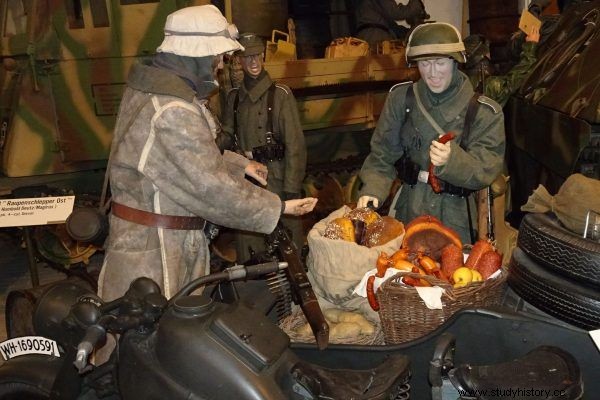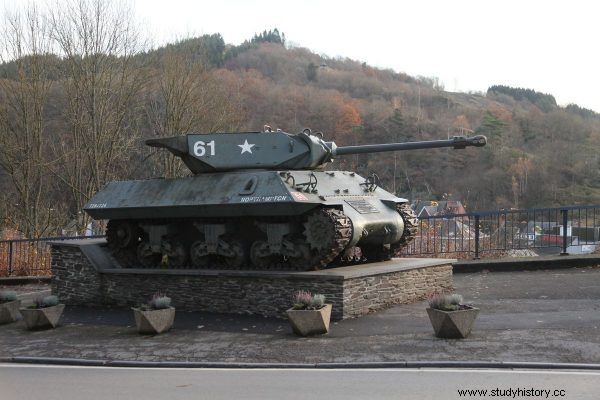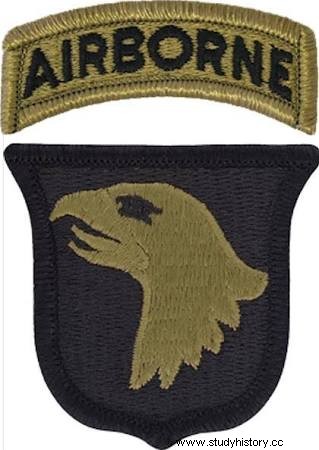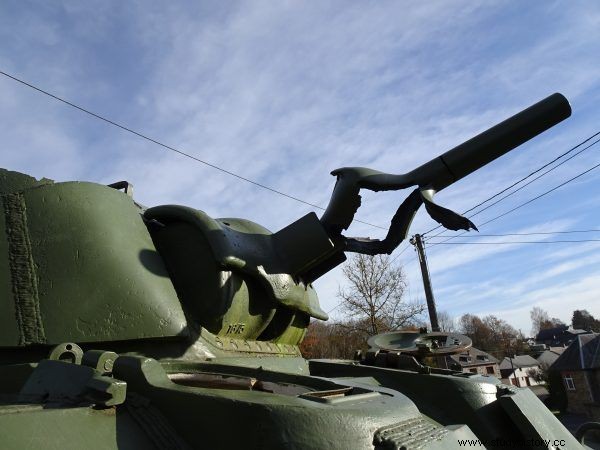Why is the battle for the Ardennes still stirring up emotions in the West? Was it because it could change the fate of the war? Or maybe because 20,000 Americans were taken prisoner then?
December 16, 1944 at At 5.30 am with an artillery barrage of two thousand guns, the German offensive in the Ardennes began. "Hitler's last gambit in the west" ultimately turned out to be a failure, but the operation prepared by his generals shocked the American and British staffers . They realized that defeating the Third Reich would not be a "walk" from town to town.

Today marks the 75th anniversary of the Battle of the Ardennes
The Germans were still dangerous, they had more and more modern weapons and equipment, so at all costs they had to be forced to surrender in 1945. It succeeded, but at the cost of great losses. A harbinger of bloody fighting on German territory was the battle that took place at the turn of 1944 and 1945 on the Belgian-German-Luxembourg border - in the Ardennes.
The Allies are resting in the Ardennes
From the Normandy landings to the fall of 1944, Allied forces made a giant leap forward, liberating almost all of France, Belgium, and most of the Netherlands. The front stopped just before the German border. Optimistic American generals expected the surrender of the Third Reich in December, and they planned to go to Berlin for the New Year's Eve party. They were wrong. The German soldiers still wanted to fight, especially since the enemy was already at the gates of their country, and their villages and cities were behind the front lines.
The offensive in the Arenas was undoubtedly a display of the "reborn" strength of the Wehrmacht and the SS. It was also another crazy idea of Hitler, who still saw a chance to settle the war in Germany's favor. His plans were opposed by General Heinz Guderian, the creator of the Blitzkrieg doctrine, who saw the greatest threat in the East and demanded that the best armored divisions be transferred to the Vistula.

German soldiers - part of the exhibition
Hitler, however, focused on the attack in the west. He believed that the Americans fought worse than the English, and that they, in turn, fought worse than the "Ivans". He also counted that the "Yanks" were discouraged from the war after nearly six months of fighting in France. Indeed, the Allied units were exhausted by the long fighting in Normandy, the Battle of Caen, the Battle of Falaise, and then the lost Battle of Arhn and the still pending Battle of the Hurtgen. American and British supply lines were very long, and the lost people and equipment were only replaced. American units that had previously fought bloody battles in France rested on the "quiet" and "less important" section of the front in the Ardennes.
The staff members did not expect any surprises from the Germans, they considered the war to be resolved, the Wehrmacht as beaten, and in their opinion, the Third Reich was supposed to chase with the rest of its strength . It is true that the American intelligence warned that the enemy was preparing something, but only the possibility of local counterattacks to equalize the front lines was allowed. If they did, they would be easily repelled thanks to the quantitative and qualitative advantage of the American troops.
The Allies also did not allow the possibility of "serious" military operations in the Ardennes, although the Germans had already carried out offensives over these mountains. Certainly, the delayed reactions of the Allied staffs to the German attack were in many cases caused by wishful thinking such as "but that's impossible", "it doesn't happen".
Germany is preparing an offensive
Meanwhile, the Germans moved over the border a powerful combat group consisting of 4 armies, 5 armored divisions and 12 infantry divisions. Taking advantage of the bad weather that prevented the Americans from reconnaissance flights, they transported more than 1,500 tanks and nearly 2,000 guns to the front lines and hid them in the woods. Prepared for the attack, among others the latest tanks, the powerful PzKpfw VI Tiger B, called by the allies "King Tigers", a large number of the latest types of PzKpfw V "Panther" and armored guns, including the dangerous "Jagdpanther" or equipped with the powerful 128 mm "Jagdtiger" . Preparations for the offensive took place in Germany. As a result, most orders were transmitted over land lines - rather than radio. So they couldn't be decoded by the British in Bletchley Park.

M-10 Achilles in the Ardennes
The German plan envisaged a strike at the meeting point of American and British troops and cutting as deep as possible into the Allied defense lines. The first target was to be the Meuse River and the bridges over it, the second target was the city of Antwerp and the city's super-important seaport . Hitler expected a major counteroffensive to shake up American society as it demands that America withdraw from the war. He also knew about the friction in the Western Allied camp, caused mainly by the British Marshal Bernard L. Montgomery "Montego", who was reluctant to the Americans. He hoped that a losing battle would lead to disputes and accusations about who was responsible for the defeat. He hoped that the result of the long battle of the Americans and the English against his menacing panzer divisions, SS units, paratroopers and people's grenadiers would result in huge human losses. They were supposed to force the Western Allies to suspend military operations on the Western Front and even decide to sign a "separatist" peace with the Third Reich.
This would allow the Germans to redeploy all troops to the east, on the line of the Vistula River and stop the Red Army preparing for a winter offensive. The signing of peace in the west, i.e. a decision similar to that during World War I, was greatly feared by Stalin, which is why he repeatedly demanded assurances from Churchill and Roosevelt that the goal of the allies was the unconditional surrender of Germany to all members of the anti-Nazi coalition at the same time and the subsequent occupation of the territory of the Third Reich.
King Tigers strike!
After the night artillery strike from 2,000 guns at At 8.30, the German armored attack began. On the north wing, Joseph Dietrich's 6th SS Panzer Army was advancing towards the Belgian city of Liège, Hasso von Manteuffel's 5th Panzer Army was advancing in the center of the front towards Sankt Vith and Bastogne, and on the south wing, Erich Brandenberger's 7th Army was moving towards Luxembourg.
With battle-hardened veterans of selected Wehrmacht and SS units marched the newly formed people's grenadier divisions (less numerous than "normal" divisions, but armed with more automatic weapons). Many of the soldiers involved in the offensive were armed with the "novelty" effective and reliable Sturmgewehr 44 assault rifles, most of them had excellent warm "parkas" jackets with fall camouflage on one side and winter camouflage on the other side. Strike units were also abundantly equipped with panzerfausts and panzerschrecks. For the period of the "last chance" offensive, the Third Reich equipped its "warriors" with the best available equipment, weapons and uniforms.
However, as it turned out, this was not enough to defeat the united US-British forces. The first problem for the Germans, from the very first hours of the fight, turned out to be the narrow roads leading to the cities in the main directions of the attacks. Even a small American unit was able to keep German armored columns on them for several hours. Destroyed, damaged or just broken tanks blocked the passage of the next one. The Americans successfully delayed the attack, not knowing that in this way they were putting a stick into the spokes of a speeding German bicycle.
Bastogne doesn't give up!
Two cities were particularly marked in the history of the Battle of the Ardennes:Sankt Vith and Bastogne. They were important road junctions with roads leading from many directions. Capturing them would enable the Germans to continue their attack and possibly transfer their units from one wing to the other. But in the middle sector of the front, the Sant Vith held out until December 20, and the Americans held roadblocks for even longer, until December 23. Conversely, strategically located Bastogne did not surrender to the end of the battle.
The heroic defense of this city was attended, among others, by hardened soldiers of the famous 101st Airborne Division "Screaming Eagles", who - instead of resting - became trucks, standing, immediately transferred to Bastogne . Shortly after they got there, the circle around the city closed. It should be added that the 101st DPD supported the 106th and 28th Infantry Divisions that had been defeated in the previous battles. Their assessment of the situation is evidenced by the fact that they created a battalion called SNAFU, which in military slang meant "situation normal, all fucked up".

Badge of the 101st Airborne Division
The defenders' situation was made worse by the fact that the weather changed from autumn to winter and it snowed. The Americans were not prepared to fight in such difficult conditions. Unlike the Germans, they did not have white camouflage uniforms, so during fights in the snow they put on white sheets, tablecloths and bed sheets on their coats. The boots of American infantrymen also did not work well in the snow, and their rifles froze at temperatures of - 20 degrees. Nevertheless, the defenders of Bastogne managed to stop the white-clad Germans emerging from the forests, who became visible only from a distance of several dozen meters.
A huge role in defending Bastogne was played by general Anthony McAuliffe, who perfectly commanded the battle for the city, skillfully shifting his troops from quieter sections to those that were under attack. He also went down in history with his adamant attitude and response to the German proposal to surrender. The answer was "nuts" - "nonsense" (and also "peanuts" - editor's note).
The Americans are responding by force
Although the American staff officers initially did not admit that they were dealing with a great offensive, they quickly realized that this was indeed the case. The subject was quickly "grasped":the commander-in-chief of the allied forces, General Dwight Eisenhower "Ike" and his famous but controversial General George Patton. When American generals assembled for Ike's conference in Verdun on December 19, it turned out that Patton had already ordered his 3rd Army to change route and prepare to attack the southern wing of the German advance.

George Patton
Patton, who loved brilliant operations and long raids, believed that the Battle of the Ardennes was a chance to smash the best Wehrmacht and SS units. In Verdun he reportedly said "The sacks put their head in the meat grinder, and this time I'm holding the handle!" . He also promised that his troops would attack the Germans within 48 hours, which might have been helped by the fact that his soldiers were already on their way and the other generals had no plans, much less gave orders.
On December 24, the weather improved, which made it possible for planes to take off. So the Dakota's small recon and large transport planes took off, supplying the beleaguered defenders of Bastogne. The P-47 Thunderbolt also entered the fray, destroying every German vehicle with rockets and bombs, if only it emerged from the forest. The situation has not been resolved yet, but the advantage has already started to lean towards the Allies, especially since the German tanks ran out of fuel and the capture of American fuel depots was unsuccessful (e.g. the fuel depot in Stavelot was blown up just before the Germans entered the city) .
On December 26, the troops of General Patton's 3rd Army reached the besieged Bastogne, and the German offensive capabilities began to run out. Designated targets of the attack were not achieved. The armored units did not even reach the Meuse, and only crossing it made it possible to develop the offensive on a larger scale and turn a tactical victory into a strategic one. The Americans, with little support from British troops, were slowly eliminating the "bulge" of the front caused by the German offensive (for this reason, in the west, the "Battle of the Ardennes" is called "Battle of the Bulge" - the battle for the bulge - editor's note). It was not until January 7 that Hitler allowed his troops to withdraw, and on January 15 American armies joined forces to close a breach in the front. Most of the German units withdrew in relative order behind the Siegfried Line, but the heavy equipment:tanks, armored guns, and artillery were lost on the narrow roads of the Ardennes. They are now exhibits in many local museums.
Bastogne, Peanuts and King Tigers
The Battle of the Ardennes went down in the history of World War II. Both sides suffered huge losses. The Americans are estimated at 19,000 killed and over 23,000 missing and taken prisoner. The German losses were similar. Only the British managed to come out unscathed from the pogrom and lost "only" 200 killed and 1,400 wounded and missing. The Germans gained nothing as a result of the offensive, except that they reaffirmed their strength, organizational and mobilization capabilities. They also revealed many of their technical innovations to the Allies, which were carefully researched.
After the defeat in the Ardennes, the Germans did not manage to rebuild their army, and above all replace the destroyed tanks and armored guns, depriving their experienced armored units of basic weapons . The German groups of 50 or 100 tanks appeared nowhere. After the Ardennes, they only numbered a dozen or so of different types. That is why the Soviet offensive in Wisła-Odra, which started on January 12, proceeded so quickly. Tanks of the Red Army, after breaking the first and second lines of resistance, broke into the practically undefended operational space and showed the Germans the Soviet version of the "Blitzkrieg", reaching the Oder in three weeks.

Sherman with a blown barrel
To commemorate General McAuliffe and the heroic defenders of Bastogne, the historic Nuts Weekend takes place every year in this city (usually around December 16-17) with Battle of the Ardennes veterans, military parades, marches and concerts of military bands, reconstruction presentations and historical reenactors, etc. On these days you can buy peanuts in all kinds of stalls and shops. Similar events, albeit on a smaller scale, are also held in other cities in the Ardennes where the war has passed.
The Ardennes is apparently not an attractive region for tourists, but it is a great place for military tourism all year round. History buffs visit cemeteries, battlefields, memorials and great museums that can be found in almost every city. It is also popular to take "ghost photos", photos taken today in places known from the fighting in December 1944.
Below we present a subjective ranking of museums recommended to visit in the Ardennes:
- Bastogne War Museum (Belgium) - a great narrative museum where the visitor plays one of the selected characters:a soldier, a civilian or a child.
- National Museum of Military History in Diekrich (Luxembourg) - a museum with many dioramas showing scenes from the fighting in the Ardennes, lots of heavy equipment, including the Enigma cipher machine!
- Museum of the 101st Airborne Division in Bastogne (Belgium) - a museum in an old tenement house dedicated to the heroic defense of the city, primarily to paratroopers in the 101st DPD. It is worth visiting the cellar where you can experience the bombing of the city
- Bastogne Barracks / Royal Belgium Military Museum - former barracks from which McAuliffe commanded the defense of Bastogne. The barracks house a huge collection of tanks and other armored vehicles from the Second World War, as well as workshops where these vehicles are repaired
- December 44 Historical Le Glezie Museum - small but very interesting museum in Le Glezie. Great exhibits, incl. many artifacts found on the battlefields of the Ardennes. A large collection of German helmets and a well-stocked shop. The main attraction is the PzKpfw VI Tiger B "Royal Tiger" standing in front of the museum.
